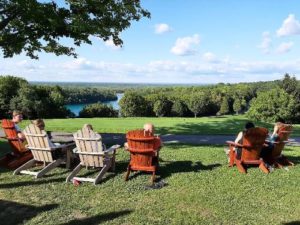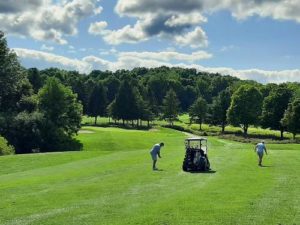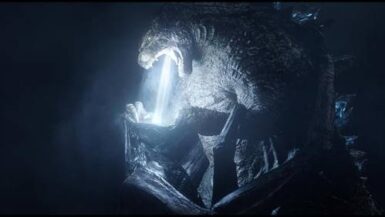
FAYETTEVILLE, NY – We all know the rags-to-riches story of Bethpage Black: a municipal golf course built in the tumult of the Great Depression survives long decades of languishing and mismanagement before being restored to its former glory and ascends into the rarified air of a major championship venue. It’s an inspiration to every public golf course.
But Bethpage Black was beloved by locals through thick and thin, even when there were stones in every bunker, weeds in all the fairways, and the USGA or PGA of America hadn’t even begun to consider it for hosting a professional event. Still, despite all those lean years, Bethpage Black was always the de facto home course of every New York City public golfer – New Yorkers are nothing if not loyal.
Four-and-a-half hours to the northwest, the Syracuse area has its own Baby Bethpage. Green Lakes Golf Course may never hold a major championship, but people still camp out in their cars overnight for a tee time. It’s located in a state park and administered by the public sector, yet like Bethpage Black (an A.W. Tillinghast masterpiece) it has a sterling architectural pedigree: Robert Trent Jones, Sr., a rich heritage it diligently preserves and protects. And throughout both lean years and prosperous eras, the locals have loved it as fervently as they did on the day in opened in 1936. Green Lakes remains to this day the beating heart of the upstate public golfer and a bedrock foundation of the regional public golf scene.
“My family and I have been coming here for 35 years, we love it that much,” recalled quintessential upstate newscaster Matt Mulcahy of WSTM, who you’ll often find taking a long morning run through the park. “It’s a true everyman golf course: it’s beautiful in any season, it’s challenging without beating you up, and it’s attracted not just generations of loyal local golfers, but vacationers from all across the state as well as many touring professionals for showcase events.”

Completed by Trent Jones in 1936 as part of upstate New York’s version of the Works Progress Administration, a program called the Civilian Conservation Corps, Green Lakes is primordial Jones, one of his oldest designs. As such, it is an excellent case study in Jones’s career, an early mile marker at which you can analyze his formative design strategies.
Jones, Sr. is best known for the penal school of architecture. As his career progressed he turned to narrow fairways guarded by bracket bunkers, elevated greens, forced carries, and water hazards as his primary defenses to scoring. The point of no return was the 1951 U.S., Open when he turned Oakland Hills into “The Monster” and, through television, inadvertently triggered the “harder is better” trend in golf design. Two old saws come to mind: first was the time Jimmy Demeret told Jones “Hey Trent, I saw a course you’d love! You stand on the first tee, and you drop a ball!” and the second was the story that when Neil Armstrong first set foot on the moon, he didn’t say “One giant leap for mankind,” he really said. “God damn that Trent Jones….”
[Author’s Note: As an aside, I told that joke to a friend of mine once, and he looked at me wide-eyed and said, “Wow…I didn’t hear anything about that in the documentary I saw…”]Anyway, Jones’s early golf holes were much more welcoming. They tended to be wider off the tee, and feature more options to play the holes. He gave players more chances to reach par-5s in two and drive par-4 greens more often than he did later in his career. Early Jones courses offer many more downhill approaches than courses designed later in the repertoire, and they often feature more interesting contours in the fairways.

Happily, Green Lakes combines all of those attributes. Two of the four par-5s are easily reachable by all golfers after a good drive, and several par-4s are a drive and a pitch. For the truly great golfer, Green Lakes can be a milk run, low hanging fruit. Lock and load; it’s time to go low.
But Green Lakes also can spring traps on the unwary, the unlucky, or the greedy. In this case it’s the wild fairway and greenside contours, coupled with undulating greens. Your wedge better be laser-precise and be prepared to shape shots both ways.
“My brother and his son always say, ‘there isn’t a flat lie on this course,'” Matt Mulcahy explained, laughing because that’s one of the highest compliments you can pay a golf course. Fairway and green contours are among the most natural and effective ways of defending par. Webb Simpson lamented just last week that architects can’t make courses long enough to challenge the Tour players, and he’s right. So what’s an architect to do? Build smaller greens with more fierce contours and surrounds.
Green Lakes and Bethpage Black share something else in common: Kevin Carroll, a crackerjack young rising star of a superintendent. Carroll spent 14 years working on the Bethpage grounds crew, starting as an intern and working his way all the way up to First Assistant Superintendent, before taking the Head Superintendent position at Green Lakes. Carroll was an integral member of the grounds crews that prepared Bethpage Black for the 2009 U.S. Open and the 2012 and 2016 Barclays FedEx Cup Playoff events.
“Working at the big tourneys taught me how to improve the playability of a golf course under any conditions, even those most hostile to healthy turfgrass and soils,” Carroll explained. He was on the ground implementing state-of-the-art practices and using all the latest greatest whiz-bang technology at the biggest golf events in the world. Now he brings that wealth of experience to Green Lakes.

“When you’re managing any golf course the greens are the priority. Since I’ve been here we’ve really concentrated on good topdressing and proper grooming and aeration,” Carroll stated firmly. “Best of all we take a minimalist approach to our use of sprays and fertilizers. We optimize playing conditions while saving money and protecting the environment.”
Carroll’s work has been a runaway smash hit. Green lakes has always been popular, but now with a head super at the helm who has professional tournament and elite-level experience, he’s brought all that knowledge into practice and the course has never been better conditioned.
“Everything I do here starts with my team – the skill set of everyone on the grounds crew and what we’ve accomplished is out of this world. I’m really grateful for the job they do. For instance, we are rebuilding all the bunkers in house and by hand. We started in October 2018 and have completed 2, 12, 14, 16, and 18. The bunkers on 13 are currently under construction. We will also be rebuilding forward tees and constructing new tees in house as well.”
BEST HOLES
Matt Mulcahy: “I like 11 and 12. On 11, the uphill dog-leg left that plays over a little valley, you must hit a great drive and a strong approach. Left is no good because the trees block you out on the approach. And at 12, the par-5, you really have to hug the left side, because the terrain slopes so severely to the right. And of course, the walk to the first tee, overlooking the lakes far below is gorgeous in any season.”

Your Author: “Agreed. Standing on the first tee of Green Lakes, you can’t help but decompress. High on a hilltop towering dizzyingly above the electric-green colored lakes below, it’s the best opening tee shot view north of New York City. I also love seven, the short, but uphill par-5 with the wildest fairway contours on the course. Up the left side, you have to carry the “Catcher’s Mitt,” a bowl-shaped section of fairway that can leave players with a wild side-hill or uphill lie for their second shot. You can also play around it too. It’s reminiscent of the architecture of Langford and Moreau, two architects Trent Jones was fond of.
And, of course, nine is a show-stopper, a thrilling 3-shotter that ascends steeply back to the clubhouse where everyone on the veranda is watching you. A rousing round of applause greets superb shots, while pained groans, chuckles, and wisecracks await mis-hits.
No pressure!”
Kevin Carroll: “Funny story about that hole. You’ll note there are two greens – side by side and almost identical to each other. The original green is the one on the right, the lower one, closer to the road. Apparently, back in the day, people occasionally sliced golf balls into the road, so they built the upper green to cut down on that…”
Your Author: “SHHH! Don’t tell them that! Tell them it was to limit the amount of foot traffic on that iconic green! Like they did at Pine Valley number eight”
Kevin Carroll: “Oh yeah! That’s right! That’s what it was! (Laughter) And don’t forget 14. It’s a fun little hole with that tee shot soaring over the hill and into the valley. For longer players it’s drive-able, but if you miss you’re begging for a par.”
Matt Mulcahy: “At the end of the day, Green Lakes isn’t just a golf course. It’s an important part of the area’s golf history. Trent Jones’s name, a gorgeous natural setting, a whole state park to explore, and best of all, it’s open to everyone. Because of that it not only maintained a loyal fan base from inception, it’s grown even more popular as time has gone on.”
Your Author: “And no matter how experienced a golf you are, it’s a fun, low impact day. As long as you don’t hit the ball at right angles to reality, you stand an excellent chance of finishing the round with one ball. Quirky interesting, but not quirky weird, it’s eminently playable for everyone.”
“My father always had a fondness for Green Lakes,” said Robert Trent Jones, Jr. “The central New York area has always been dear to our whole family, since we spent so much of our lives here. It’s wonderful to see and hear how well the club is doing. It’s great that the public get to play one of my Dad’s all-time favorites.”




